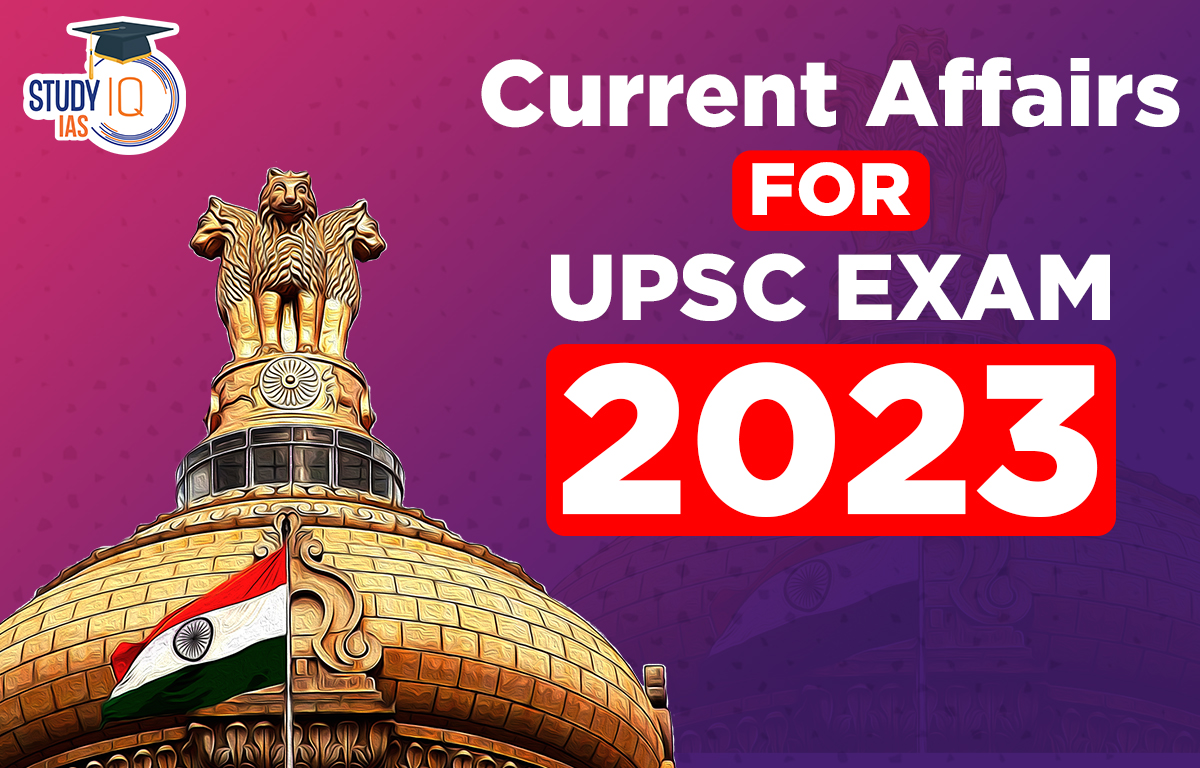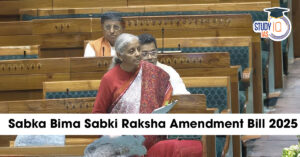Current Affairs 12th April 2023 for UPSC Prelims Exam
Mucormycosis
Context: The first case of a human being infected by a plant fungus has come to light.
More on the News:
The fungus, Chondrostereum purpureum, is responsible for causing silver leaf disease in plants, especially in species of roses, rhododendron, plums, apricots, and cherries.
Fungi Infection in Humans
- Despite being present abundantly in the environment, a limited number of them have the ability to infect animals and humans.
- Transmission: Exposure to contaminated soil, wood or plant material. They can enter through cuts/abrasions or through inhalation, can transmit the fungi.
- Symptoms: Persistent cough, hoarseness of voice, recurrent pharyngitis, fatigue, swallowing difficulty, sore throat and anorexia.
- Treatment: The fungal infection can be treated through the use of antifungal medications, with the course depending on severity.
Significance of the Development
- Disease caused by plant pathogens are relatively new in humans but can have serious implications for the emergence of infectious diseases.
- The risk of cross-kingdom pathogens has grown due to global warming and climate change.
- It also shows that pathogens such as fungi are benefitting from natural selection-adaptation strategies and ability to tolerate higher temperatures.
- The ability of such pathogens to evade strong immune system of humans is also a cause of concern since it was believed that they mostly affected immune-compromised individuals.
Current Affairs 11th April 2023 for UPSC Prelims Exam
Good Friday Agreement
Context: The US President is visiting Belfast, the capital of Northern Ireland, to mark the 25th anniversary of the Good Friday Agreement.
What is the Good Friday Agreement or Belfast Agreement?
- Good Friday Agreement : The Good Friday Agreement was signed on April 10, 1998, between Northern Ireland, and the governments of Britain and Ireland, to end 30 years of violence ( known as ‘The Troubles’,) in Northern Ireland among those who wished to remain with the United Kingdom (UK) and those who wanted to join Ireland.
- The US had played a key part in negotiations building up to the agreement.
- Cause of Violence: The conflict in Northern Ireland dates back to when it became separated from the rest of Ireland in the early 1920s.
- Great Britain had ruled Ireland for hundreds of years, but it split off from British rule – leaving Northern Ireland as part of the UK, and the Republic of Ireland as a separate country.
- When this happened, the population of Northern Ireland was divided in two:
- Unionists, who were happy to remain part of the UK – some of them were also called Loyalists (as they were loyal to the British crown)
- Nationalists, who wanted Northern Ireland to be independent from the UK and join the Republic of Ireland – some of them were also called Republicans (as they wanted Northern Ireland to join the Republic of Ireland).
- Unionists were mostly Protestant, and Nationalists were mostly Catholic.
- When Northern Ireland became separated, its government was mainly Unionist. There were fewer Catholics than Protestants in Northern Ireland.
- Catholics were finding it difficult to get homes and jobs, and they protested against this. The Unionist community held their own protests in response.
- During the 1960s, the tension between the two sides turned violent, resulting in a period known as the Troubles.

- Terms of Agreement:
- Northern Ireland would remain part of the UK, but could join Ireland if, in a referendum, a majority of people on both sides voted for it.
- People born in Northern Ireland could have Irish or British nationality or both.
- Weapons by paramilitary groups would have to be decommissioned, but people in jail for violence so far would be released.
- Northern Ireland would get a new government, where both the nationalists and unionists would be represented. This devolved government would have powers over most local matters, while the UK government would look after security, foreign policy, tax laws, immigration rules, etc.
- On May 22, 1998, a referendum was held in Ireland and Northern Ireland, and the agreement was approved by 94% of voters in Ireland and 71% in Northern Ireland.
Pradhan Mantri Fasal Bima Yojana (PMFBY)
Context: Recently, The Prime Minister expressed happiness over the impact of the Pradhan Mantri Fasal Bima Yojana.
About PMFBY:
- PMFBY is a large-scale crop subsidy insurance scheme that was aimed to safeguard farmers.
- Launched in 2016 and is being administered by the Ministry of Agriculture and Farmers Welfare.
- It is in line with the One Nation – One Scheme theme– It replaced National Agricultural Insurance Scheme (NAIS) and Modified National Agricultural Insurance Scheme (MNAIS).
- The primary goal of the initiative is to reduce the burden of insurance premiums on farmers and ensure early settlement of claims.
- Coverage:
- The scheme provides coverage for the entire cropping cycle from pre-sowing to post-harvest and midseason adversities.
- All food & oilseed crops and annual commercial/horticultural crops for which past yield data is available.
- Eligibility:
- Farmers including sharecroppers and tenant farmers growing notified crops in the notified areas are eligible for coverage.
- Objectives:
- To provide insurance coverage and financial support to the farmers in the event of failure of any of the notified crops as a result of natural calamities, pests & diseases.
- To stabilize the income of farmers to ensure their continuance in farming.
- To encourage farmers to adopt innovative and modern agricultural practices.
- To ensure the flow of credit to the agriculture sector.
- Insurance Coverage or Premium:
- Farmers have to pay a maximum of 2 percent of the total premium of the insured amount for Kharif crops, 1.5 percent for rabi food crops and oilseeds as well as 5 percent for commercial/horticultural crops.
- The balance premium is shared by the Union and state governments on a 50:50 basis and a 90:10 basis in the case of northeastern states.
- The premium rates to be paid by farmers are very low and the balance premium will be paid by the Government to provide the full insured amount to the farmers against crop loss on account of natural calamities.
- There is no upper limit on Government subsidies. Even if the balance premium is 90%, it will be borne by the Government.
Recent Updates in PMFBY
- Before 2020, the scheme was compulsory for loanee farmers, but the Centre made it voluntary for all farmers.
- In February 2020, the Centre decided to cap the premium subsidy at 30% for unirrigated areas and 25% for irrigated ones, which was previously unlimited. The central subsidy had no maximum limit earlier.
- For more efficiency and transparency center introduced Weather Information and Network Data Systems (WINDS), a Yield Estimation System based on Technology (YES-Tech), and the Collection of Real-Time Observations and Photographs of Crops (CROPIC).
Guru Tegh Bahadur
Context: Parkash Purab of Sri Guru Tegh Bahadur, the ninth guru of the Sikhs, was celebrated on April 11.
About Guru Tegh Bahadur
- The Guru was born in Amritsar in 1621 to Mata Nanki and Guru Hargobind, the sixth Sikh guru, who raised an army against the Mughals and introduced the concept of warrior saints.
- At the age of 13, Tegh Bahadur distinguished himself in a battle against a Mughal chieftain. His bravery and heroic swordsmanship in the battle earned him the name of Tegh Bahadur. (“Tegh” is ‘sword’ in Punjabi.)
- He stood up against forcible conversions by the Mughals.
- He was an avid traveler and played a key role in setting up preaching centers throughout the Indian subcontinent.
- He set up his headquarters in present-day Anandpur Sahib in 1665.
- He founded the town of Chak-Nanki in Punjab, which later became a part of Punjab’s Anandpur Sahib.
- Martyrdom: Aurangzeb ordered the public execution of the Guru on November 11, 1675 after he declined to embrace Islam.
- At the site of Guru Tegh Bahadur’s execution stands Gurdwara Sis Ganj Sahib in Delhi’s Chandni Chowk.
- Teachings: His writings are housed in the sacred text, ‘Guru Granth Sahib,’ in the form of 116 poetic hymns.

Mahatma Jyotirao Phule
Context: Prime Minister has paid tribute to the great social reformer, Mahatma Jyotirao Phule on his birth anniversary.
About Jyotirao or Jyotiba Phule (1827–90)
- He was born on 11th April, 1827 in Satara, Maharashtra, belonged to the mali (gardener) community
- He led a powerful anti-upper caste and brahminical supremacy movement.
- He was a prolific social activist and thinker who helped pioneer women’s education in India, particularly in Maharashtra.
- Contributions:
- Women Education: He and his wife Savitribai established the first school for girls in India in Pune in 1848.
- Widow Remarriage: He established an ashram for young widows and eventually became an advocate of the idea of Widow Remarriage.
- Satyashodhak Samaj: In 1873, Phule established the Satyashodhak Samaj (Truth Seekers’ Society), with the samaj’s leadership drawn from the backward classes, including malis, telis, kunbis, saris, and dhangars.
- It is believed that Phule coined the term ‘dalit’ (meaning crushed) to describe those who do not belong to the varna system.
- Title of Mahatma: He was bestowed with the title of Mahatma on 11th May, 1888 by Maharashtrian social activist Vithalrao Krishnaji Vandekar.
- Major Publications: Tritiya Ratna (1855); Powada: Chatrapati Shivajiraje Bhosle Yancha (1869); Gulamgiri (1873), Shetkarayacha Aasud (1881).

QuaDream Spyware
Context: Recently, Microsoft Internet watchdog said Israeli spyware Quadream was used to hack across 10 countries.
About QuaDream
- Quadream Spyware is a type of malware that is designed to infiltrate and compromise electronic devices.
- It can monitor a wide range of activities on the infected device, including keystrokes, browsing history, and other sensitive information.
- Quadream Spyware can be used for various malicious purposes, such as stealing personal data, intellectual property theft, financial fraud, espionage, and cyber-attacks.
- It can spread through various channels, including malicious websites, email attachments, software downloads, and social engineering tactics.
Protection against Spyware
- Regularly update the device’s operating system and security software.
- Avoid clicking on suspicious links or downloading software from untrusted sources.
- Use strong and unique passwords for your online accounts.
- After a spyware attack immediately disconnects the device from the internet and seeks professional help from a cybersecurity expert.



 Future of Governance in Post-Maoist Indi...
Future of Governance in Post-Maoist Indi...
 Sabka Bima Sabki Raksha Amendment Bill 2...
Sabka Bima Sabki Raksha Amendment Bill 2...
 MP Police Answer Key 2025 Out at esb.mp....
MP Police Answer Key 2025 Out at esb.mp....

























